The next day, Gustavo and I got up early, at 6 o’clock, and already by 7:15 we were on our way to visit the site of the ancient civilization Tiwanaku. While we were going to a terminal to catch transportation to Tiwanaku, Gustavo told me that the former railway station that was turned into the main coach terminal of La Paz in the meantime was designed by no less than famous Gustave Eiffel, the same one who designed the Eiffel Tower in Paris!
The day was beautiful – sunny, but also cold, since Tiwanaku is situated at the altitude of around 4000 m. It was great to be there. There were almost no other visitors, so we could enjoy the site in peace.
The Tiwanaku civilization started to exist around 1000 BC and it lasted until before the Incas came to this region. It used to be a very powerful and rich civilization. It is supposed that at its height, Tiwanaku was inhabited by some 100,000 people. Its success was primarily based on exceptionally skilful agricultural production that made it possible not only to feed all those residents, but also to get surplus crops that were then used for trading. This was all feasible because they constructed elevated terraces with water canals that ensured optimal irrigation or drainage of the soil in the terraces and that also created micro-climate thus contributing to very high yields. Still, at some point the civilization started to decline and it is presumed that this happened as a result of climate changes. Today this entire area appears completely infertile and very few people, only around 7,000 of them, live here. They are very poor, but there are some experimental projects trying to reintroduce the ancient techniques for growing crops. By the way, these areas, that are collectively called the Altiplano (Plateau), are traditionally inhabited by the Aymara nation. Their ancestors were conquered first by the Incas some time in the 15th century and later by the Spaniards. Today, the Aymara mostly live in Bolivia, but they also inhabit parts of Peru, Chile and Argentina.
But, let me go back to Tiwanaku. The site is not particularly large and there are comparatively few visible remains, but there are good reasons for that. Sorry, there are reasons, but they are not good by their nature. When the Spaniards came, there were still numerous buildings, but there was also gold which the Spaniards then took over or, to be more precise, stole. After that, others also came and took various other pieces for different museums and private collections around the world. And finally, le coup de grace was given at the beginning of the 20th century when some of the remains were blown up by dynamite in order to get gravel for the construction of the nearby railway line. To make the whole horrible thing even worse, the railway line does not even function any longer. What a disaster!
There are several sections at the site. We first went to see what is perhaps the most important artefact in all of Tiwanaku – the Gateway of the Sun. It is partially damaged, because the place where it is today is not the original place in which it used to stand. Some people had nothing better to do, so they decided to move the 10-ton gate here. Be as it may, the Gateway of the Sun was carved out of a single block of stone. In the middle, above the passage, there is a presentation of the main deity, the god creator, the god of thunder, whom the Aymara call Thunupa, but who is somehow better known under its Inca name and that is Viracocha.
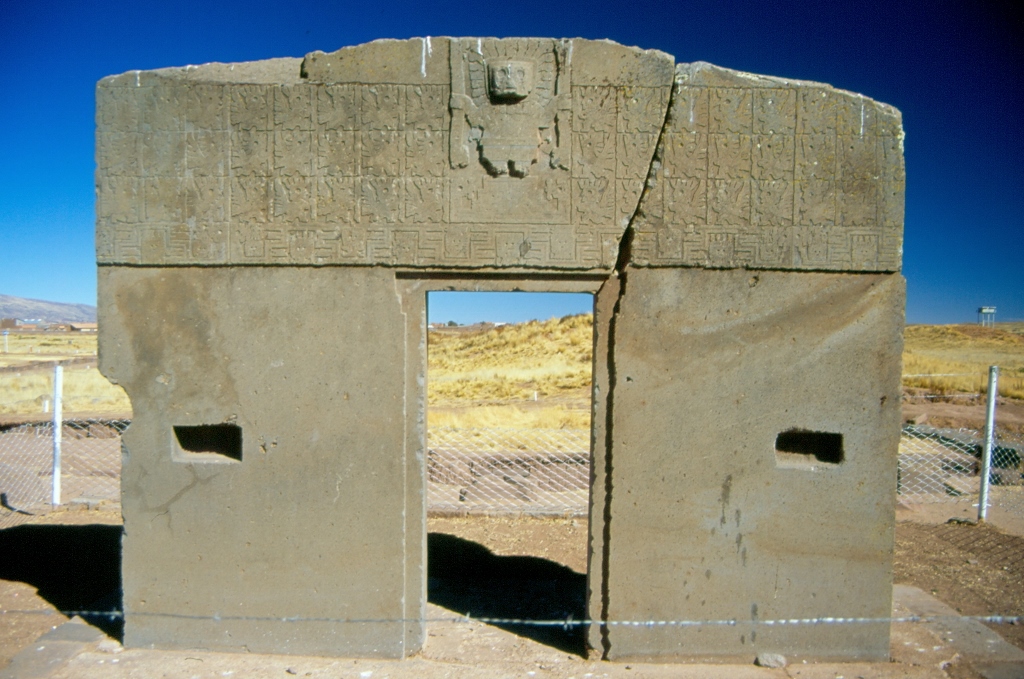 Tiwanaku, the Gateway of the Sun (Puerta del Sol)
Tiwanaku, the Gateway of the Sun (Puerta del Sol)
Close to the Gateway of the Sun there is also a monolith representing a standing figure that holds a cup against his chest. There is also a type of an altar that was built there and that is used when traditional festivities are organized at the site – like renaissance or the revival of ancient customs and renewed celebration of early gods. Namely, when the Aymara New Year and the winter solstice come, and this is on 21 June since this is taking place on the southern hemisphere, many people come here and organize gatherings and ritual celebration of their ancestors and tradition. When I visited Tiwanaku, I could still see the remaining ashes and ritual offerings at the altar.
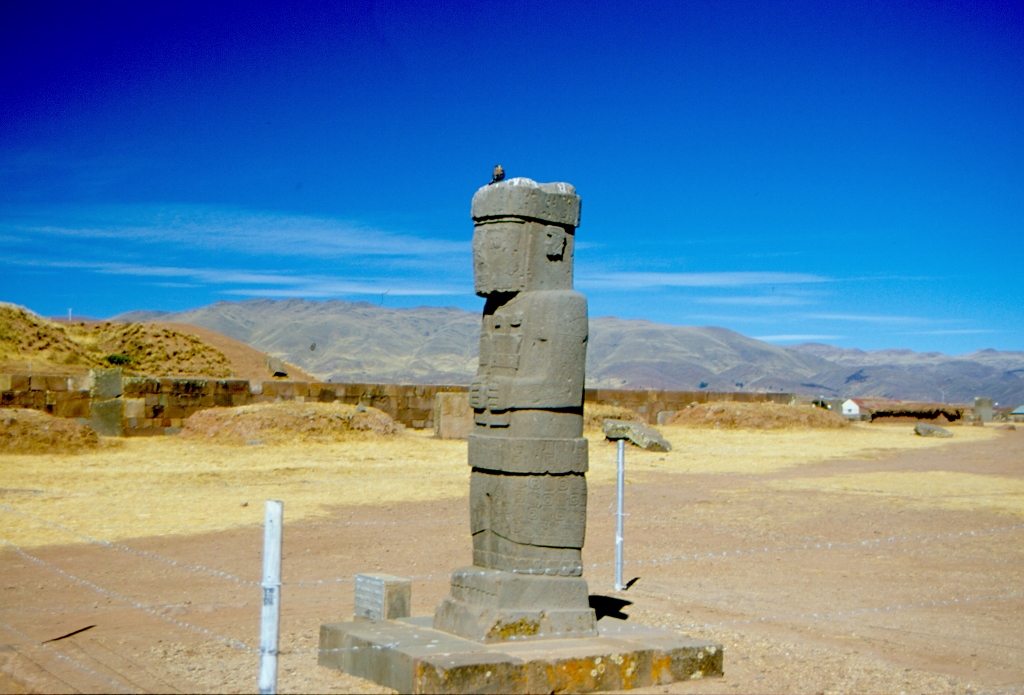 Tiwanaku, a 3-metre high statue
Tiwanaku, a 3-metre high statue
Both the Puerta del Sol and the huge anthropomorphic statue are situated on a large platform, Kalasasaya, the base of which is supported by a stone wall. The wall was made of large upright megaliths, some 4-5 m high, with smaller rocks arranged between them. It is also possible to see pieces of stone that were carved out to such a shape that they serve as drainage for the water that gets onto the raised area and that are placed at regular distance along the wall, thus ensuring even drainage of water from the platform when the rains start.
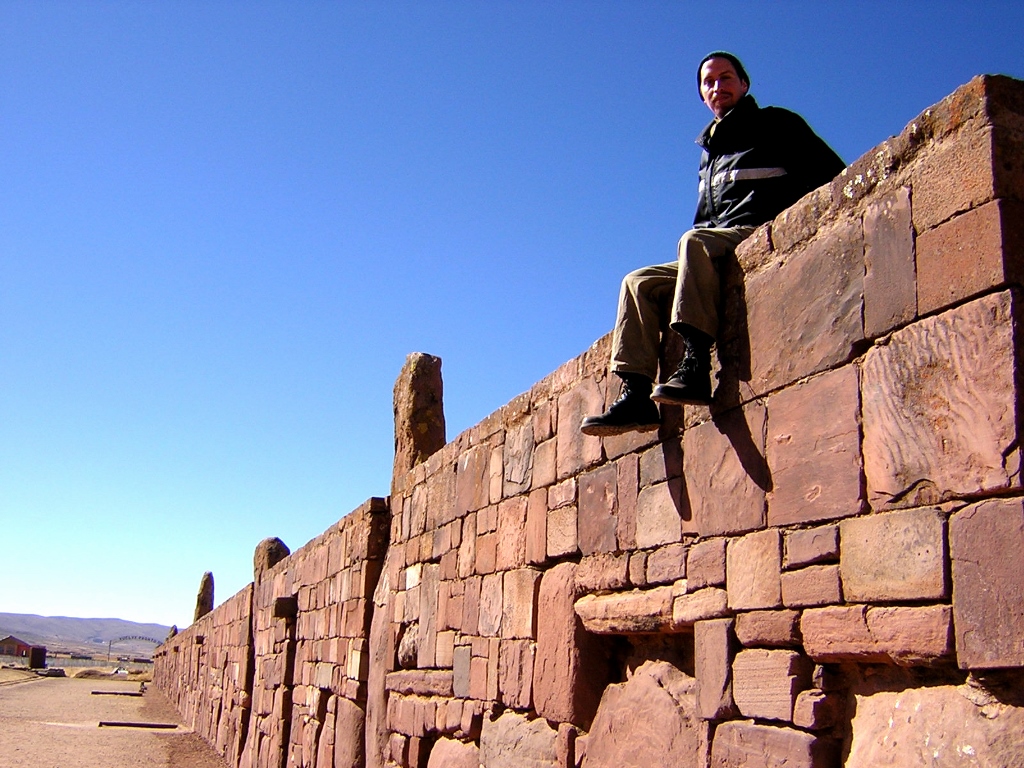 Gustavo and the perimeter wall of Kalasasaya in Tiwanaku (Photograph courtesy of GD)
Gustavo and the perimeter wall of Kalasasaya in Tiwanaku (Photograph courtesy of GD)
Going around Kalasasaya, we came to the Semi-Subterranean Temple. It is located on the east side of the platform where there is the main gate and stairs that lead onto the platform, but that were closed when I was there. This Semi-Subterranean Temple is a very interesting place. It looks like an empty swimming pool, 2 metres deep and around 30 x 30 m. Its inner walls are adorned by stone heads or rather depictions of faces. Some of the heads are better preserved, some have already decayed, but what is interesting is that there are no two same faces and there are lots of them - 175. There are suppositions that these show different races that used to exist within the empire, but that is again not too clear and is in fact puzzling, because the official history tells us that only local Indians used to live here before the arrival of the Caucasians. Other suppositions say that these were symbolically heads of defeated enemies, thus, again symbolically, taking additional power away from them. And there are also theories that these show aliens, for some of the faces are not sufficiently human and it is clear that they knew how to carve human features.
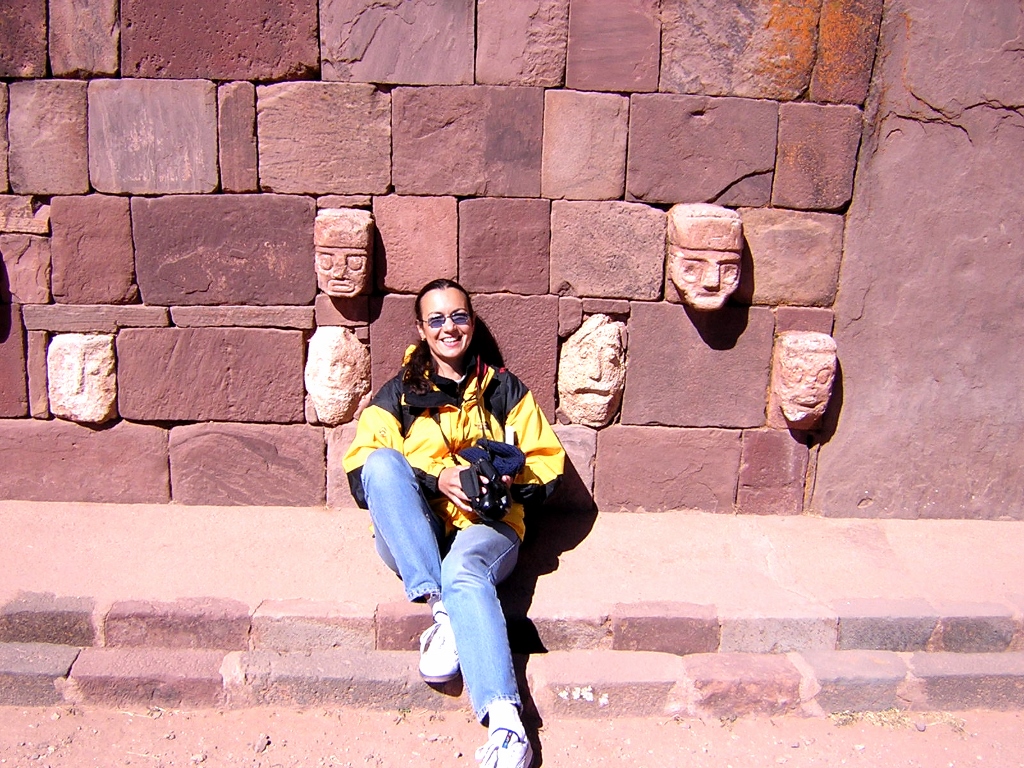 In the Semi-Subterranean Temple, Tiwanacu (Photograph courtesy of GD)
In the Semi-Subterranean Temple, Tiwanacu (Photograph courtesy of GD)
In the centre of the Semi-Subterranean Temple there are also three monoliths one of which has particularly interesting depiction of hands that are positioned asymmetrically which suggests a motion, a rarely found element.
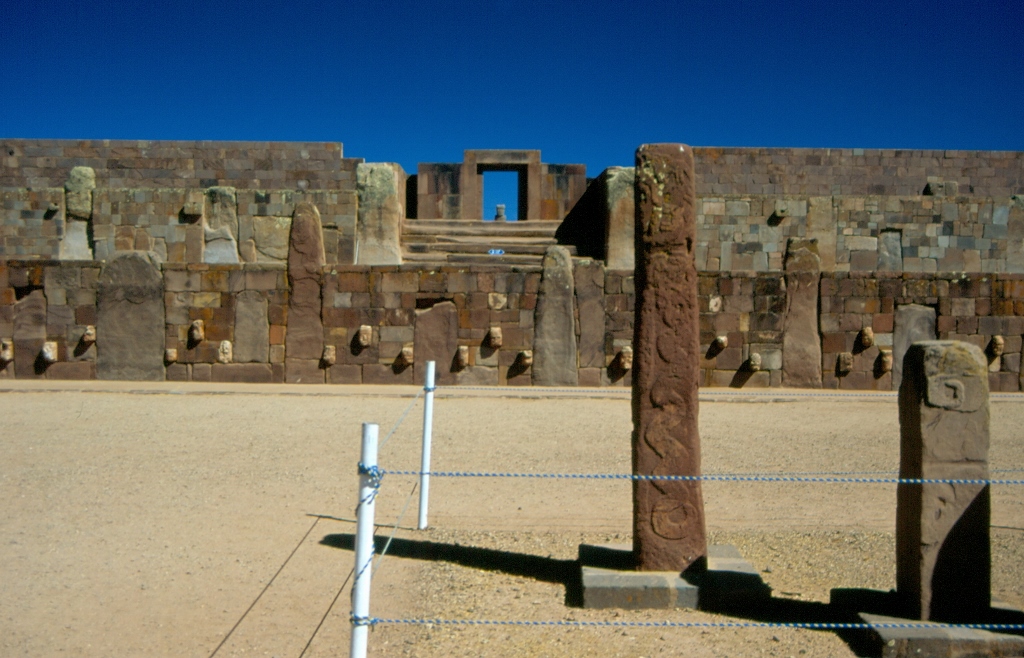 View from the Semi-Subterranean Temple: it shows monoliths in the centre of the temple, the Temple walls with the stone heads, the stairway and gate that lead onto Kalasasaya and the monolith with its hands on the chest that stands on the platform
View from the Semi-Subterranean Temple: it shows monoliths in the centre of the temple, the Temple walls with the stone heads, the stairway and gate that lead onto Kalasasaya and the monolith with its hands on the chest that stands on the platform
Then Gustavo and I continued with our walk around the site. There are also remains of a large terraced pyramid there named Akapana and it is presumed that this used to be the most important edifice in the settlement. Earlier it was thought that the pyramid was natural, but as it turned out later it was all man-made. The base is 180 m long, 140 m wide and the pyramid is 18 m high. Today it really looks more like a hillock covered by grass, but here and there it is still possible to see remains of the original seven terraces. One of the guards there told us that what we could see then was but a fraction of what was yet to be excavated at the site. As we approached the mound, we saw some very interestingly carved stones and then we climbed the hill or rather the pyramid.
The top of the pyramid provides an excellent view at the Kalasasaya platform and the Semi-Subterranean Temple, with the peaks of Illimani in the east. I found it particularly fascinating when I became aware of the movement of the Sun. Namely, when you turn towards the side where the Sun would be at noon, you would then face the north, while the Sun would appear to move from the east, on your right, via the north, to the west, on your left. So, all entirely contrary in comparison to the situation in the north hemisphere.
Then Gustavo and I started to go back home and the road took me again across the breathtaking landscapes of the Altiplano.
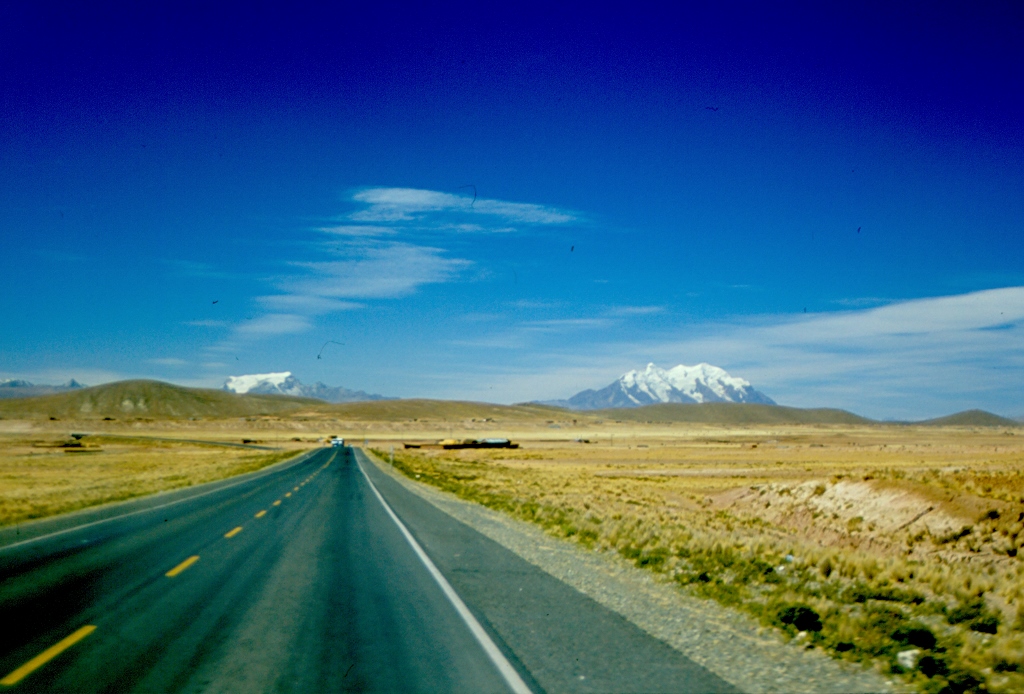 On the road between Tiwanaku and La Paz. Illimani is on the right-hand side.
On the road between Tiwanaku and La Paz. Illimani is on the right-hand side.
Before returning home, we stopped at El Alto. These are actually the higher parts of La Paz that are situated across the completely flat section of the plateau. From there, the ground abruptly declines as if cut off and this is where La Paz spreads as if it were a broad waterfall coming down the slopes. El Alto used to be considered a suburb of La Paz, but now it is taken as a separate town. It is said to be significantly more dangerous for living, but it is also politically and socially volatile. A little before my coming to Bolivia, there had been some demonstrations and popular unrests in El Alto and entire La Paz was completely blocked. Nothing or rather nobody could come in or go out of it for some period of time or could but with serious difficulties. Under such circumstances it turned out that it was good that Bolivia had two capitals, so all segments of the state moved to Sucre in order for the country to be functional.
The reason why we went to El Alto was to go to the local flea market. I hoped to find a good suitcase or a bag for me, but there was nothing I liked. However, we did find something my belly liked – super fantastic food – zonzo! The already cooked yucca is mashed and then mixed with cheese and some other condiments, and this turns out to be like some dough. Then, this is shaped up into a sausage form around a 1-cm thick stick, put on a special grill resting on the ends of the stick and then roasted from all sides. Super, super tasty!
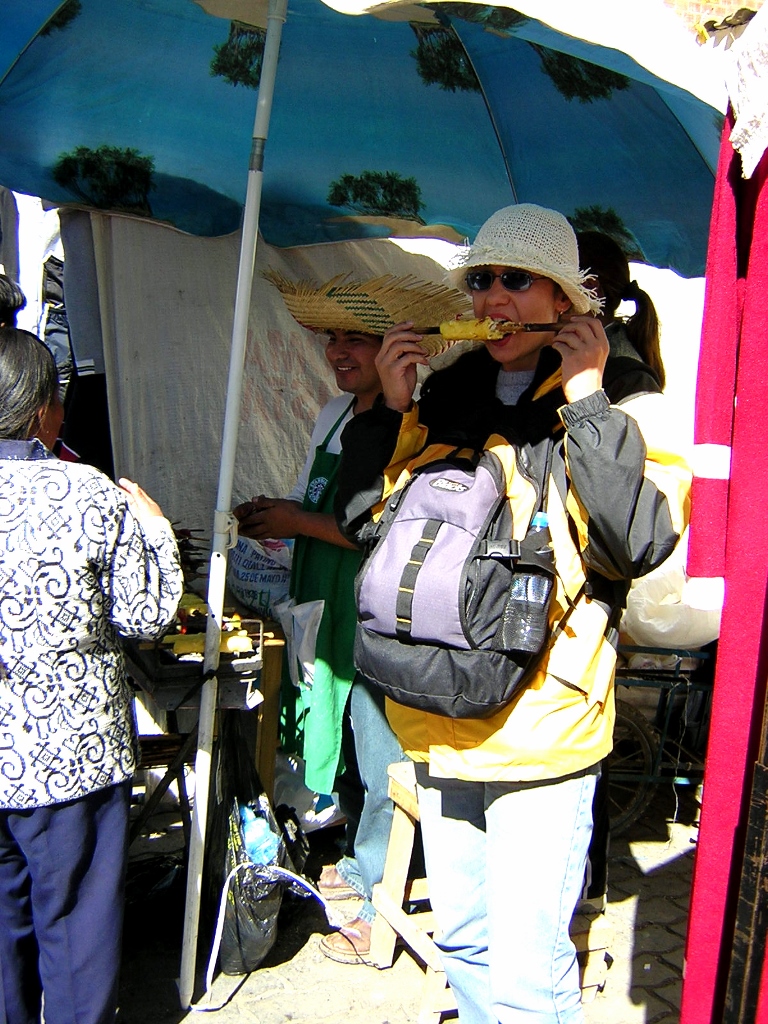 Zonzo, yummy! (Photograph courtesy of GD)
Zonzo, yummy! (Photograph courtesy of GD)
After meandering through the market, we went downtown and there we came across a parade of students from different faculties who danced and played music, and it was all a lot of fun. They were in fact getting ready for the University celebration that was to be held the following weekend, so the main street through which the parade moved was closed to traffic.
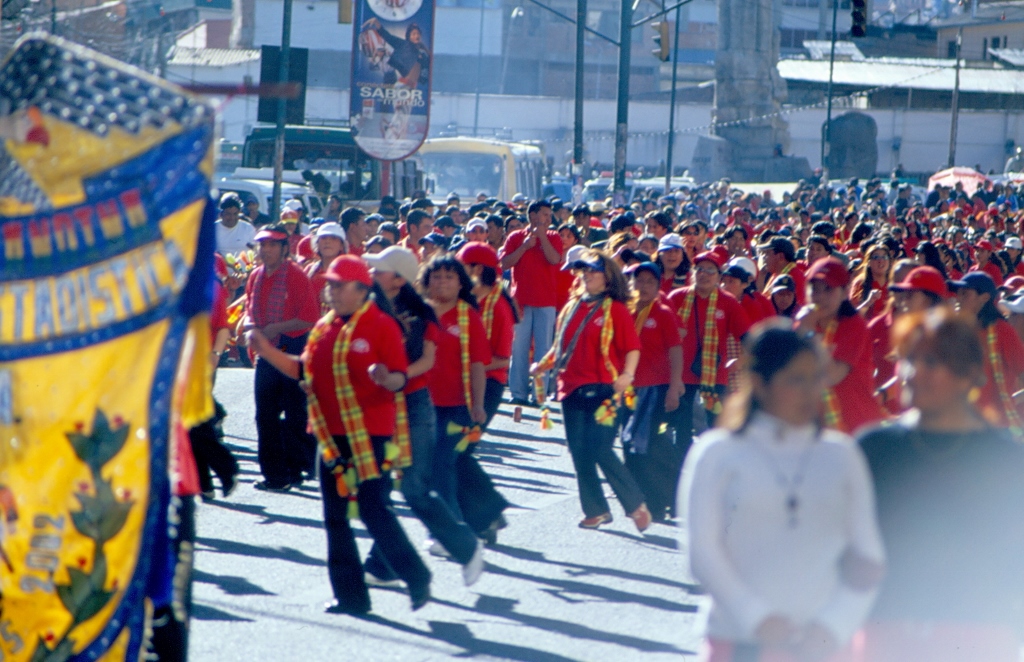 The main rehearsal for Entrada Universitaria, La Paz
The main rehearsal for Entrada Universitaria, La Paz
Afterwards we finally went home where I chatted with Gustavo's mother and sister. I also took advantage of the nice weather to wash my laundry and let it dry in the sun.